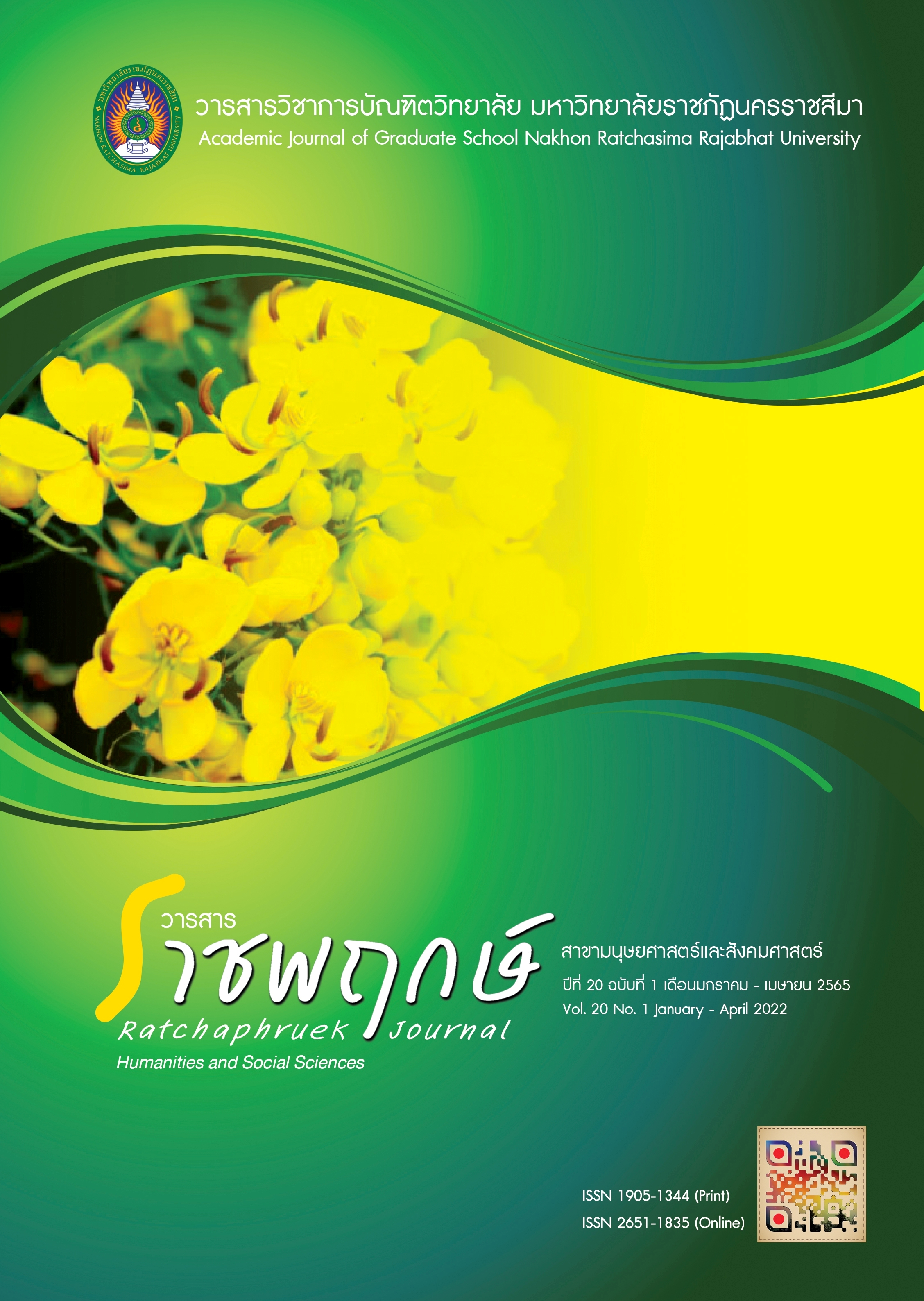แนวทางการสืบทอดคุณค่าฮูบแต้มอีสาน: วัดท่าเรียบ อำเภอนาโพธิ์ จังหวัดบุรีรัมย์
Main Article Content
บทคัดย่อ
งานวิจัยนี้มีวัตถุประสงค์เพื่อวิเคราะห์คุณค่าฮูบแต้มอีสานของวัดท่าเรียบ อำเภอนาโพธิ์ จังหวัดบุรีรัมย์เก็บข้อมูลจากเจ้าอาวาส รองเจ้าอาวาส ผู้ใหญ่บ้าน อาจารย์ผู้สอนรายวิชาศิลปะ ปราชญ์ชาวบ้านและชาวบ้าน รวม 16 คน ด้วยแบบวิเคราะห์เนื้อหาแบบสัมภาษณ์เชิงลึก และแบบสังเกตแบบไม่มีส่วนร่วม โดยใช้แนวคิดคุณวิทยาและศึกษาแนวทางการสืบทอดคุณค่าฮูบแต้มอีสาน ในฐานะเป็นเครื่องมือพัฒนาชุมชนและเป็นมรดกทางวัฒนธรรมที่ส่งผ่านความคิด ความเชื่อ ค่านิยม ภูมิปัญญา และความเป็นอีสานเฉพาะพื้นที่จากรุ่นสู่รุ่น ผลวิจัยพบว่า การสืบทอดคุณค่าฮูบแต้มอีสานในปัจจุบันเกิดขึ้น 2 ลักษณะ คือ 1) ผ่านวิถีชีวิตของคนในชุมชน คือ การร่วมพิธีกรรมทางศาสนาของผู้สูงอายุและวัยรุ่น ภูมิปัญญาการทอผ้า เส้นทางท่องเที่ยวเชิงวัฒนธรรม และวรรณกรรมมุขปาฐะ และ 2) ผ่านการจัดการศึกษาในระบบโรงเรียน ในลักษณะการพาชมฮูบแต้มอีสาน ในรายวิชาต่างๆ สำหรับแนวทางการสืบทอดคุณค่าฮูบแต้มอีสาน คือ การฝึกมัคคุเทศก์รุ่นเยาว์อย่างต่อเนื่อง ควรมีการให้ความรู้เบื้องต้นในการดูแลฮูบแต้มแก่คนในชุมชนและนักท่องเที่ยว และการสร้างสื่อประชาสัมพันธ์ ที่ส่งเสริมการท่องเที่ยวเชิงวัฒนธรรมปัจจัยที่ส่งเสริมให้เกิดการสืบทอดคุณค่าดังกล่าว คือ วัดและโรงเรียน ยังคงเป็นพื้นที่รวมจิตใจของคนในชุมชน อีกทั้งเจ้าอาวาสยังคงรักษาพิธีกรรมโบราณ อาทิ พิธีฮดสรง งานบุญ เข้ากรรม จัดขึ้นเป็นประจำทุกปี ทำให้เกิดการแลกเปลี่ยนทางวัฒนธรรมระหว่างชุมชนใกล้เคียงอย่างต่อเนื่อง
Article Details

อนุญาตภายใต้เงื่อนไข Creative Commons Attribution-NonCommercial-NoDerivatives 4.0 International License.
เอกสารอ้างอิง
แก้วตา จันทรานุสรณ์ และทรงวิทย์ พิมพะกรรณ์. (2560). สินไซ: มรดกภูมิปัญญาทางวัฒนธรรมกับการส่งเสริมการมีส่วนร่วมทางการเมือง. กรุงเทพฯ: กรมส่งเสริมวัฒนธรรม กระทรวงวัฒนธรรม.
จรูญ โกมุทรัตนานนท์. (2547). สุนทรียศาสตร์ กรีก-ยุคฟื้นฟู. กรุงเทพฯ: จุฬาลงกรณ์มหาวิทยาลัย.
ฉัตร สืบสำราญ. (2552). การคงอยู่ของพุทธศาสนาในการรับรู้ของชาวบ้านจากภาพจิตรกรรมฝาผนังสิม วัดท่าเรียบ บ้านหนองหว้า ตำบลนาโพธิ์ จังหวัดบุรีรัมย์ (วิทยานิพนธ์มหาบัณฑิต, มหาวิทยาลัยมหาสารคาม).
ชวลิต อธิปัตยกุล. (2555). ฮูปแต้ม: มุมมองทางด้านประวัติศาสตร์ศิลปะพื้นถิ่น บนแผ่นดินอีสาน. อุดรธานี: เต้า-โล้.
_______. (2559). ฮูบแต้มในวัฒนธรรมลาว-ลาวล้านช้าง ความโยงใยเชื่อมโยงสืบทอดรูปแบบกับฮูบแต้มของประเทศไทย. อุดรธานี: เต้า-โล้.
ทรงวิทย์ พิมพะกรรณ์. (2560). ฮูปแต้มสินไซ: ทุนวัฒนธรรมเพื่อการพัฒนาชุมชนบ้านสาวะถี. ใน ทรงวิทย์ พิมพะกรรณ์, และมารศรี สอทิพย์ (บ.ก.), ฮูปแต้ม: มรดกทางวัฒนธรรมสองฟากฝั่ง, (น. 125-132). ขอนแก่น: มหาวิทยาลัยขอนแก่น.
บุญจันทร์ เพชรเมืองเลย. (2559). สุนทรียรสในวรรณกรรมสินไซที่ปรากฏในฮูปแต้มอีสาน. ใน บทความวัฒนธรรมลุ่มแม่น้ำโขง, (น. 1-11). ขอนแก่น: ศูนย์ศิลปวัฒนธรรม มหาวิทยาลัยภาคตะวันออกเฉียงเหนือ.
วรวุฒิ โรมรัตนพันธ์. (2548). ทุนทางสังคม. กรุงเทพฯ: โครงการเสริมสร้างการเรียนรู้เพื่อชุมชนเป็นสุข.
สุมาลี เอกชนนิยม. (2548). ฮูปแต้มในสิมอีสาน งานศิลป์สองฝั่งโขง. กรุงเทพฯ: มติชน.
อติญา วงษ์วาท. (2564). การสืบทอดคุณค่าฮูบแต้มอีสาน (วิทยานิพนธ์ดุษฏีบัณฑิต, จุฬาลงกรณ์มหาวิทยาลัย).
อู่ทอง ประศาสน์วินิจฉัย. (2551). ซ่อนไว้ในสิม ก-ฮ ในชีวิตอีสาน. กรุงเทพฯ: ฟูลสต๊อบ.


